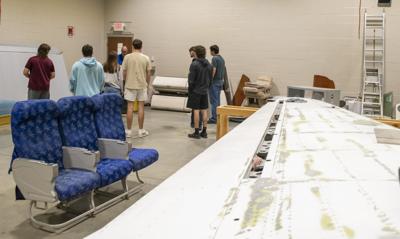It takes a pilot with a license to fly a plane. But it’s not just the pilot who keeps planes in the air and the Elmore County Technical Center has an aviation program training tomorrow’s aviation technicians. It’s a program that is sure to lead to high paying jobs. James Stough started the program from the ground up in 2018 after he served in the military and worked in the industry.
“Delta is begging for 40,000 airframe and powerplant technicians,” Stough said.
There are also the manufacturers such as Airbus, Boeing, Rolls Royce and more paying more than $50 per hour after just a few years experience.
The option to provide a decent living without a four-year college degree encouraged the parents of Wetumpka sophomore Lincoln McQueen.
“I don’t know if I want to go to college right out of high school,” McQueen said. “I thought a technical career is the right way to go. I heard aviation has a lot of job opportunities. They need a lot more pilots, technicians and air traffic controllers.”
In the classroom, Stough is teaching students the differences between steel, aluminum, titanium, fiberglass, kevlar and carbon fiber use in aircraft. He is helping students understand where and how the different materials can be beneficial in a plane. Carbon fiber is super strong and light. It can be used on panels for instrumentation or wings like the Boeing 787.
“The wings will curl up in flight,” Stough told the students. “They will flex up. The wings will move up to 12 feet from level. It is that flexible and strong. If metal moves that far, it will crack.”
Later in the school year the students will go to the lab where they will construct panels from fiberglass cloth and resin. Thanks to donations from his contacts still in the industry, Stough has plenty of parts to show his students in the ECTC hangar. Last week, the students saw how fiberglass is used as an aerodynamic cowling around a propeller at the front of a small plane and how light the overhead bins in a passenger airliner are.
Stough used the short demonstration to explain the differences in the various jobs in the aviation industry. He said there are crews specialized in removing just the interior parts of an airplane such as seats and overhead bins. Those same crews will also install new or refurbished parts to the interior. But he said since those jobs are not related to airframe and powerplant (A&P) and they don’t pay as well.
There is a wing from a damaged Hawker 400 business jet in the hangar. Stough is using it to teach students how to use the tools of the industry to remove and maybe replace the skin of the wing. Stough will use the dissection process to show students the fuel tanks, pumps and plumbing in the wing.
Stough said the FAA is responsible for A&P certifications. Without military experience it will take two years in a community college environment before students can test for A&P certification. Those in the military with 18 months of continuous service in an A&P area can then take a two week class before the FAA testing.
In both cases the jobs are there.
“I had a student at Coastal Alabama Community College,” Stough said. “He was hired before he ever graduated. He called me up and said he was going to make $24 starting out as a 19 year old.”
The prospects of getting raises are there too.
Stough has other students at Auburn University and Embry Riddle in various programs to become a pilot or technician. Some students aspire to other jobs in the aviation industry.
“I plan to go to MIT after graduation,” Holtville sophomore Gabriel Maggard said. “I want to study aeronautics and plan to work for the Air Force as an aeronautical engineer.”
Stough said he has former students pursuing aviation engineering so Maggard isn’t alone.
But first students must get through Stough’s class and his final exam — constructing and launching a model rocket from a kit. The process mimics on a small scale what A&P technicians do.
“You have to lightly sand the balsa wood,” Stough said. “You take the square edges and making them round. They have to be able to delicately put it together. We take it to the ballfield with a launch system. I said all it has to do is launch and you get an A.”
But the process of following detailed instructions accurately can get into the heads of even his most experienced students.
“I have third year students who get super nervous,” Stough said. “They don’t want to mash the button but if they want a grade, they have to.”













